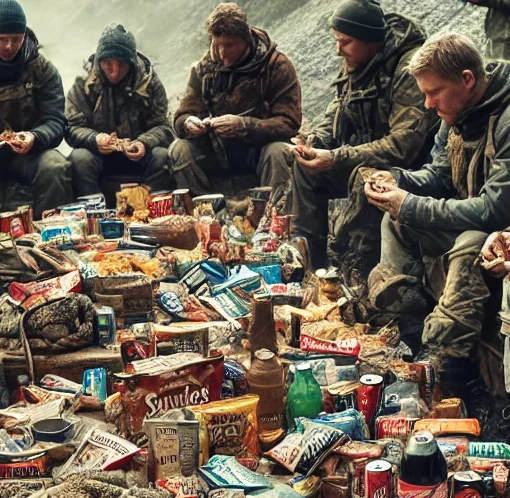We never want to think about emergencies until, well, we’re smack-dab in the middle of one. And by then, it’s too late. You’re trying to find your shoes, the dog’s running circles around the living room, and the kids are screaming because, “Mom, we can’t leave without my favorite stuffed bear!” Fun times, right? That’s why having an emergency plan before everything hits the fan is crucial.
But here’s the kicker: It has to work for everyone. It’s not just about you or your partner knowing the exit routes or where the flashlights are stashed—it’s about the whole family being on the same page. Even if that page is covered in sticky jam from breakfast.
Don’t Forget The Kids (Yes, Even If They’re Tiny)
 Kids are like mini chaos machines. They absorb info like sponges, but half the time, it seems like they can’t remember what day it is, let alone where to go in an emergency. That’s why you need to keep it simple. We started small with my kids—fire drills at home.
Kids are like mini chaos machines. They absorb info like sponges, but half the time, it seems like they can’t remember what day it is, let alone where to go in an emergency. That’s why you need to keep it simple. We started small with my kids—fire drills at home.
We pretended there was a fire, and everyone had to follow the plan. They thought it was a game. Little did they know, I was secretly training them for real life.
The key is repetition, but not in a way that bores them to tears. Mix it up. One day, the emergency is a fire. The next, it’s a zombie apocalypse (Hey, you never know).
The important thing is, they know what to do without you having to shout instructions over the sound of a smoke alarm or, worse, total panic. And trust me, if your kids know how to escape a fire without melting down, you’re already winning.
Pets: The Furry, Four-Legged Variables
 You’d think the dog would just run out the door, right? Nope. My dog once tried to hide under the bed during a thunderstorm, and let me tell you, getting a 60-pound Labrador out from under there was no small task.
You’d think the dog would just run out the door, right? Nope. My dog once tried to hide under the bed during a thunderstorm, and let me tell you, getting a 60-pound Labrador out from under there was no small task.
He wedged himself into that space like it was his personal fortress, leaving me tugging at his collar while he gave me those big, pleading eyes as if to say, “No way am I coming out!” In an emergency, pets aren’t always as rational as we’d hope.
So, have a plan for them too. Don’t be that person who forgets the dog in a panic. Designate someone—one of the kids, maybe?—to grab the leash and the pet carrier. Make it part of your family’s emergency protocol. It might feel like adding another job to the assembly line of chaos when things go awry, but trust me; it makes all the difference.
Visualize this: when the alarm blares or disaster strikes, instead of scrambling around searching for Fido while everyone else is darting for safety, your designated pet wrangler knows exactly what to do. They’ll have the leash ready in one hand and perhaps even some treats in their pocket to coax your furry friend along.
It’s about creating a routine so ingrained that even in moments of stress or fear, everyone knows their role. You’ll thank me later when Fido isn’t lost two blocks away while you’re waving around a soggy dog treat trying to get him to come back. Instead, you’ll be safely outside together as a family—human and canine alike—ready to tackle whatever comes next with everyone accounted for.
Plus, think about how much easier it will be on your pet! Animals can sense our anxiety and may react unpredictably during emergencies. By having a plan in place that includes them as part of your escape strategy, you’re not only ensuring their safety but also reducing everyone’s stress levels.
So take some time now—when everything is calm—to sit down with your family and create an emergency action plan that includes your pets. Practice it occasionally so that when real life happens (and let’s face it; it often does), everyone knows exactly what to do without hesitation. After all, our pets are family too; they deserve just as much consideration when preparing for unexpected situations!
Communication Is Key (But Don’t Overthink It)
 I remember when my family first tried to set up a meeting point in case of emergencies. We thought we were being thorough by picking three different locations, but it quickly spiraled into a full-blown debate. “Should we meet by the oak tree? No, wait, the mailbox! How about the neighbor’s driveway?” Each suggestion led to more confusion and opinions, turning what should have been a straightforward plan into a chaotic discussion.
I remember when my family first tried to set up a meeting point in case of emergencies. We thought we were being thorough by picking three different locations, but it quickly spiraled into a full-blown debate. “Should we meet by the oak tree? No, wait, the mailbox! How about the neighbor’s driveway?” Each suggestion led to more confusion and opinions, turning what should have been a straightforward plan into a chaotic discussion.
The lesson learned: Keep it simple, folks. Choose one clear spot—whether it’s right outside your house or at a trusted neighbor’s place. This isn’t meant to be a scavenger hunt; you’re not trying to make things more complicated than they need to be. A single designated location eliminates confusion and ensures everyone knows exactly where to go in an emergency.
For families with older kids who have cell phones, communication becomes even more crucial. Make sure everyone understands who to text or call if they get separated. In the heat of the moment, they’re far more likely to reach for their phones to update Instagram or check social media than to think about contacting you for safety.
To reinforce this rule, hold regular family discussions about your emergency plan. Make it fun—maybe turn it into a game where each person takes turns explaining the plan aloud. This not only helps everyone remember but also fosters teamwork and understanding among family members.
Additionally, consider creating a small card with essential information like your meeting point and emergency contacts that everyone can carry in their wallets or backpacks. This way, even if panic sets in during an emergency, there’s a tangible reminder of what needs to be done.
Ultimately, clarity is key. Simplifying your emergency communication plan will help ensure that when chaos strikes, your family can respond swiftly and effectively without second-guessing themselves. Trust me—you’ll thank yourself later when everyone knows exactly where to go instead of wandering aimlessly around town!
Final Thoughts (Or, Why You Need To Do This Like… Now)
Look, making a family emergency plan isn’t the most glamorous task. But here’s the thing—when something goes wrong (and at some point, it will), you’ll either be running around like a chicken with its head cut off, or you’ll be that cool, calm family who strolls out the front door with everyone in tow, including the dog, because you practiced.
You don’t need to make it fancy or complicated. Just make it work. And if you can get the kids on board without bribing them with extra screen time, even better.
Here are some external resources that you might want to check out:
1. Ready.gov – Family Emergency Plan: A comprehensive guide from FEMA that helps families create a personalized emergency plan.
2. American Red Cross – Emergency Preparedness: Resources and tips on how to prepare for various emergencies, including family safety checklists.
3. CDC – Preparing Your Family for Emergencies: Guidelines from the Centers for Disease Control and Prevention on how to prepare your family for different types of emergencies.
4. National Safety Council – Family Safety Tips: Offers insights into creating a safe environment at home and preparing for emergencies as a family unit.
5. KidsHealth – Helping Kids Prepare for Emergencies: An article focusing on how to involve children in emergency planning, making it easier and less intimidating for them.




